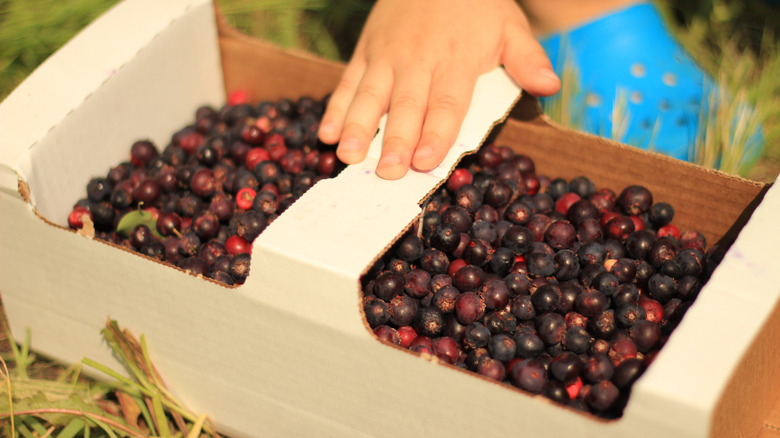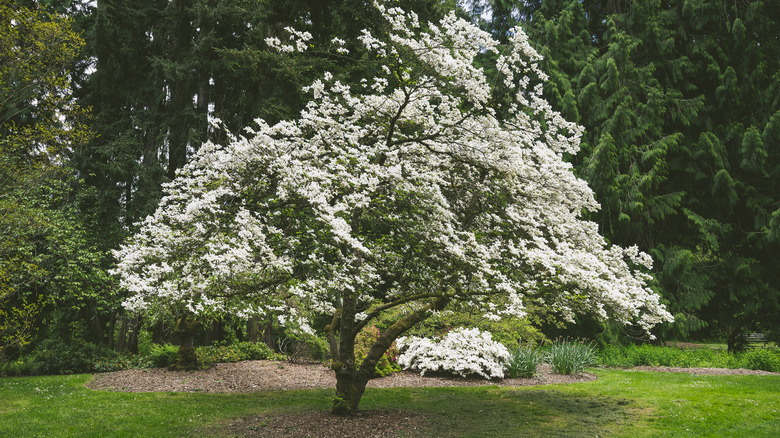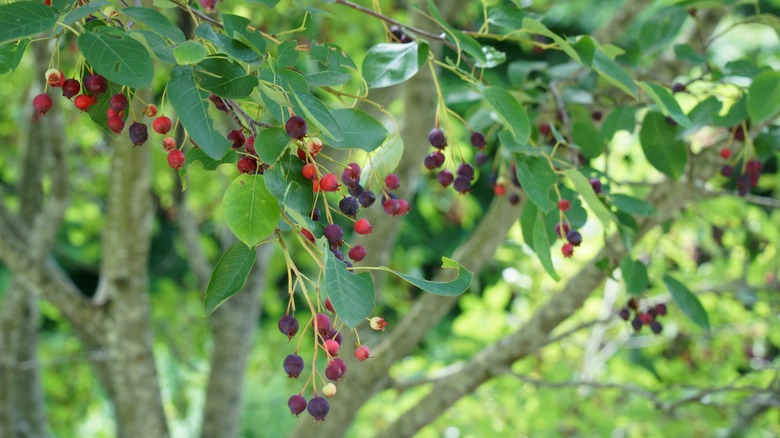The Hardy Tree That Survives In Poor Conditions And Provides Tasty Fruit
Who doesn't dream of stepping outside in the morning to pluck fresh oranges, apples, or peaches from a fruit tree in their yard? While the idea of fresh, natural fruit is universally appealing, fruit trees can be notoriously difficult to grow, and there are many things to consider before growing a fruit tree in your backyard. After assessing your environment, you may learn that you're not able to grow your favorite fruit in the area where you live. Fruit trees are picky about their soil type, sunlight, and nutrients, and they're often susceptible to pests and diseases. If you're new to growing fruits, it can be good to start small and think local. One hardy native fruit tree that will survive and produce fruit in even the trickiest conditions is the juneberry!
Snowy mespilus, Amelanchier, service berry, shadbush, saskatoon berry ... the juneberry tree goes by many names, but whatever you prefer to call it, this underappreciated fruit tree is a brilliant choice for gardens of all kinds. Here's what you need to know about planting and growing a juneberry tree and our tips for ensuring that your juneberry thrives and produces its versatile fruit.
The juneberry is independent and easy to grow
The juneberry tree is native to North America and grows in the wild almost everywhere across the country, from the forests of Canada down through Texas and Florida. For centuries, juneberries were frequently used by Native Americans for making pemmican, a nutrient-dense and shelf-stable food consisting of berries, dried meats, and animal fat. Juneberries are somewhat of a wonder, taxonomically speaking. Although their fruits look very similar to blueberries, juneberry trees are more closely related to apples and pears. In fact, juneberries are actually a member of the rose family, so if you've ever felt the urge to munch on a luscious, juicy rose, the juneberry could be a close second!
The juneberry tree is a hardy yet beautiful and productive and uncommon fruit tree you can grow in your garden. Unlike many other fruit trees, juneberries will do very well in moist clay soil, and although they prefer full sun, they can grow in partial shade. In extremely wet areas like the Northeast, juneberries can be susceptible to diseases like rust, powdery mildew, leaf spot, and fire blight, but ensuring they get enough sunlight should dry out their leaves enough to avoid infection.
Encouraging juneberries to fruit
Juneberry trees are pretty hardy and will usually survive without much interference from gardeners, but there are some actions you can take to support your tree and help it produce plenty of tasty fruits. If needed, prune the tree minimally in fall or early spring before new leaf buds emerge, and enrich the soil once per year with a thick compost mixture. Juneberries can self-pollinate, but they fare best when grown near another juneberry, so don't be afraid to scatter these beautiful trees throughout your space! The tree will flower in spring with delicate white star-shaped blooms, and the fruit will ripen in mid-summer.
Although they're part of the rose family, juneberry fruits taste similar to wild blueberries and are great for making jams, pies, or even traditional pemmican. Of course, they can also be enjoyed raw! Juneberries are one of the best native fruit trees that will bring a bountiful harvest to your yard, not only for you but for local wildlife too. Keep an eye on the fruits as they ripen and watch out for birds, which will quickly pluck all the fruits off the tree before you can get a taste. Juneberries are a great source of nutrients like vitamin C, vitamin E, magnesium, iron, and biotin, but even if you don't take advantage of its lovely fruits, the juneberry tree will also provide unique foliage that changes colors with the seasons.


